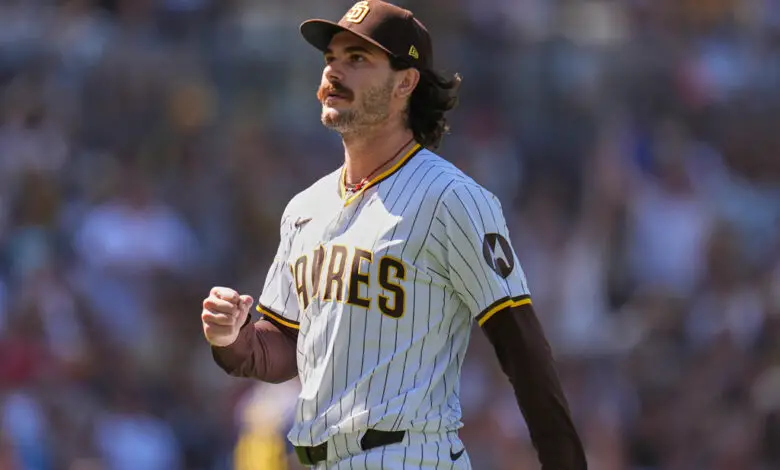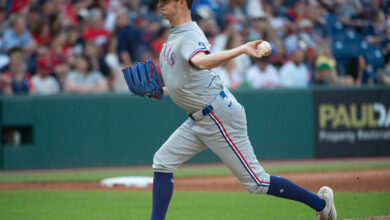
The Rundown: Cubs’ 3 Spending Paths, King & Cease Both Possible Targets, Stop Trying to Trade Ian Happ
As we await meaningful movement across the offseason landscape, we’re left with little else to do but guess at the Cubs’ strategy. Will they turtle up to survive the labor storm on the horizon, or will they take advantage of other teams’ passivity to put themselves firmly in the driver’s seat for another playoff run? Maybe it’s neither and they’ll let the market come to them.
Recent reports, not to mention Jed Hoyer’s historical behavior, seem to indicate they’ll take either the former or latter path. But there’s an argument to be made for heading down the middle, so let’s examine the options to see what they’re most likely to do.
Pay for pitching, improve offense from within
Yesterday’s column laid out the basics of the Cubs’ payroll situation, which sees them with around $52.5 million to spend sans penalty. They also have something like $118 million in financial obligations falling off after next season, which effectively means they won’t have to worry about repeater penalties if those still exist under the new CBA. Even if their uncertainty about that new deal causes them to remain conservative, it seems obvious that a big pitching addition is a strong possibility.
“I believe that with Shōta coming back, that there is going to be one more significant pitcher added to this list (of potential Cubs starters) between now and Opening Day,” Jon Morosi told MLB Network on Tuesday. “Michael King has been on the Cubs’ mind. Dylan Cease has been on their mind.”
Cease is expected to earn north of $25 million annually, with King coming in around $20 million for fewer years. That alone makes King a more likely target, though I don’t personally care much for another starter throwing 93-94 mph. Even though he’s done a good job of missing bats and avoiding hard contact, almost all of King’s value last season came from his changeup.
He’s also got a higher walk rate than I care for, especially when we’re talking about someone who struck out fewer batters and gave up more homers last year than in the past. Maybe that’s a product of injuries and he’s primed for a breakout. If I’m gambling on a big pitching addition, I’ll take the guy with elite velocity and strikeout numbers.
The Cubs have been linked to several other pitchers, including Framber Valdez and Ranger Suarez, but Japanese star Tatsuya Imai could be the most attractive of all. He could command $150 million or more, but he’s the youngest of the group and has a big fastball that touches triple digits.
All of those options would mean investing up to half of their “available” funds on one player, which could leave them having to get creative in adding two bench bats and up to six relievers. Signing King for his projected $20 million and filling the bench for $10 million would leave around $22.5 million for those relievers, but we should also consider that Hoyer likes to leave a budget buffer of at least $5 million for in-season moves. That means rebuilding a bullpen for around $3 million AAV per pitcher, which would be a stretch even for Hoyer.
And if they manage to bring Brad Keller back, he’s going to cost a lot more than $3 million over more than one year. The Cubs have proven they can build a competent ‘pen on the cheap, so it’s entirely possible that strategy will work again. However, avoiding the luxury tax penalty will mean they can’t add an expensive bat to help replace Kyle Tucker‘s production.
“I think internally, they may feel they have that solution,” Levine told 670 The Score’s Mully & Haugh earlier in the week, drawing skeptical remarks from the hosts. “First of all, it might not be Owen Caissie. It might be Ballesteros at your DH and Suzuki in right field. Do you have a problem with Suzuki in right?”
This was noted in a previous column, but there is a logical argument to be made for a number of different players improving their own production enough to offset what Tucker offered. That would be a different story had the would-be superstar remained healthy and played at a high level in the second half, so it’s a big stretch to say the Cubs can find internal solutions to what Tucker could have given them.
Find Value in Deflated Markets
This is Hoyer’s specialty, and it might be aided by other teams using the strong potential for a lockout as a reason to avoid spending at the top of the market. Rather than pursuing their targets right out of the gate, the Cubs could sit back and seek value in players who didn’t get the offers they expected.
Maybe Chris Bassitt or Lucas Giolito ends up looking for a pillow deal and takes even less than their estimates of two years and less than $40 million. Or perhaps the Cubs look to Cody Ponce, who is coming back to MLB after a very strong season in Korea. Ponce, who turns 32 in April, will probably only get around $20-25 million for two years and could provide the kind of value Hoyer covets.
With Cade Horton as the ace, Shōta Imanaga back under the QO, Justin Steele possibly returning at or near the start of the season, Matthew Boyd looking good, and Jameson Taillon bringing up the rear, the Cubs might just look for rotation depth. Securing the future with a big addition could be prudent given both the uncertainty and lack of control over that group, but Hoyer might see fit to punt such a big contract until after they know what the future holds.
The same could be said for adding offense, which could either come in the form of Alex Bregman or in sticking with smaller contracts to augment internal growth. If the Cubs are confident in Caissie and Moises Ballesteros to play supporting roles while Matt Shaw evolves into a more impactful hitter, they will be content to see if a hitter or two gets left out in the cold and gets desperate for a prove-it deal.
Take Advantage of Situation to Spend Big
While I don’t dismiss the possibility that Bruce Levine and George Ofman — who said the Cubs were “stunned” by Imanaga accepting the QO — are sharing legitimate insight, it’s also possible the front office is playing games. I find it very hard to believe they were surprised by Imanaga’s decision, as that would make them very stupid on a number of levels. To that end, it could be that Hoyer and Co. are downplaying their potential aggressiveness.
Though they’ve done nothing to prove to us that their payroll budget will suddenly expand much beyond the first penalty level of $244 million, this would be the time to do it. As of this writing, Dansby Swanson is their only non-rookie-contract position player under team control beyond 2026. Taillon, Boyd, and Imanaga could all be free agents as well.
If the Cubs don’t do some multiyear deals this winter, they’re looking at replacing eight more players for 2027. Rather than using that eventuality as a reason to stay passive, they could go big to add cornerstone pieces that could provide a foundation for that reload next winter (or whenever the lockout ends). This is the least likely route based on their past actions, but it makes the most sense if they’re serious about winning.
I think they’re more likely to go with one big pitching addition and more value-based fill-ins, but I’d love to be wrong.
Let’s Talk About Happ…Again
As is the case every offseason and trade deadline, the public discourse has mandated that I once again explain that Ian Happ is a very good player who will not be traded. He holds full no-trade power and has expressed on more than one occasion that he wants to remain in Chicago. Even if the Cubs were somehow able to convince him that he’d be better off somewhere else, their limited trade partners and his status as a rental mean they’d have to take a relatively low return.
And no, convincing him to accept a deal does not mean they should bench him until he relents. A lot of folks seem to have this idea that he’s easily replaceable, and some even think he’s bad. No one is saying Happ is a superstar — which seems to be where the disconnect lies — but averaging 3.35 fWAR over the last four seasons means he’s been worth his $20.33 million AAV.
Good luck finding a better player on the open market than that, and good luck getting Caissie to match that production. I’m not dismissing the ginger, just saying that people tend to vastly overestimate the likelihood of even the best prospects putting up Happ’s numbers.
I’m sure we won’t have to revisit this topic again between now and the end of July.
Trailer Time
I was going to add another topic, but this thing is already too long. Five Nights at Freddy’s 2 probably doesn’t fit our demographic, but the original was a fun gateway movie for young horror fans, and I actually enjoyed it as well.

